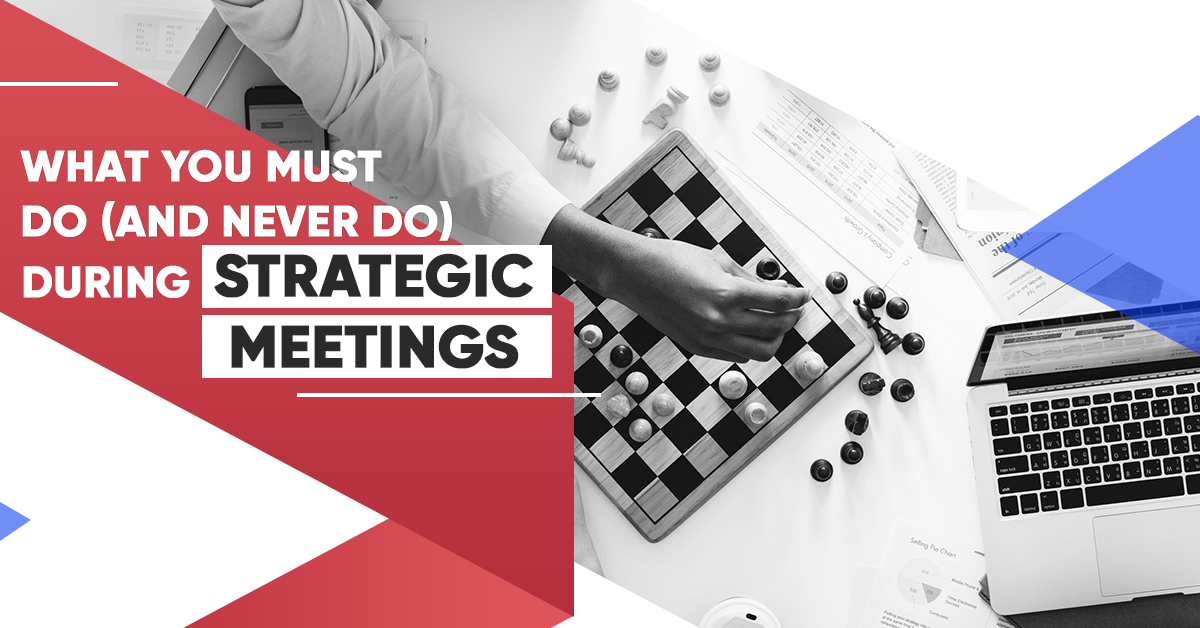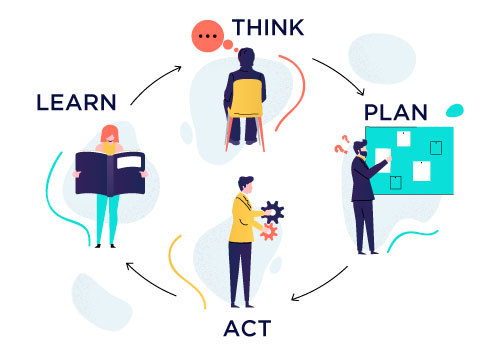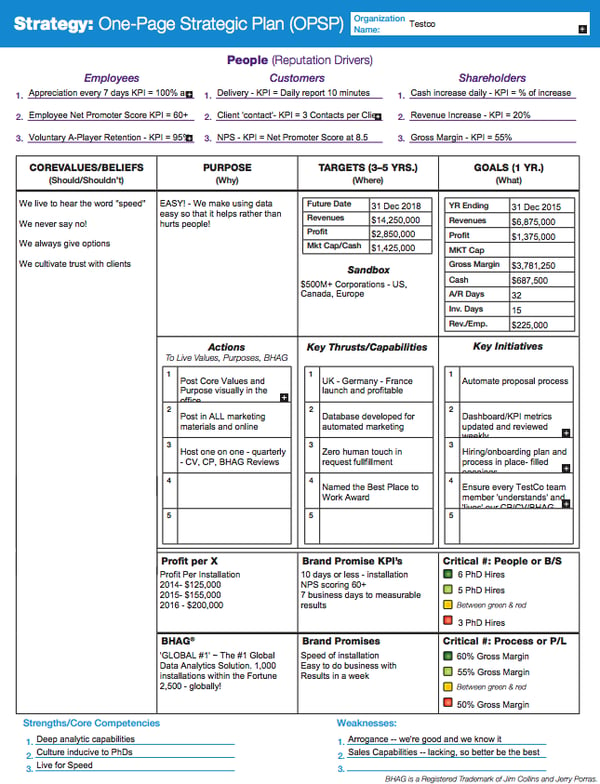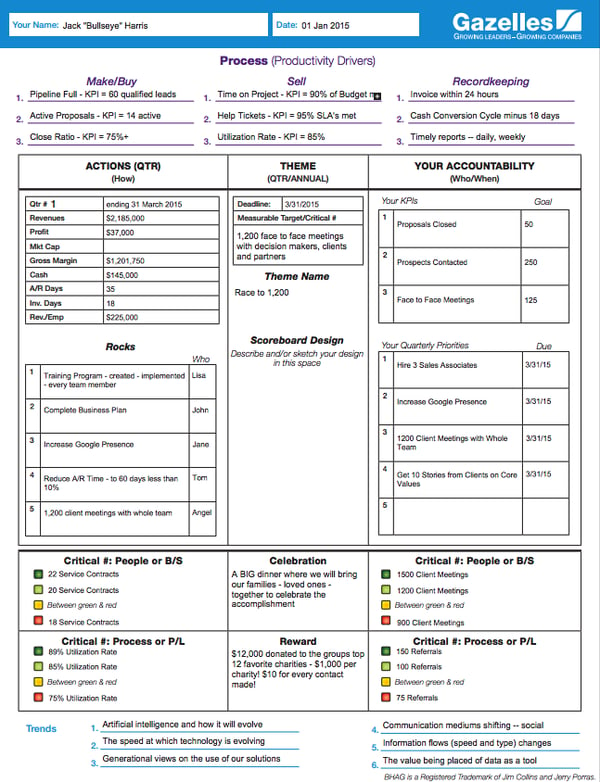What You Must Do (and NEVER do) During Strategic Meetings

To successfully scale a business, you’ll need to do three things effectively: preparation, execution, and follow-through. This isn’t something that just happens by chance for the lucky few.
In helping companies scale up over three decades, I’ve found that those who execute the 10 Rockefeller Habits to engage their team in proper strategic planning will almost always experience improved growth, revenue, and profits.
So what is strategic planning, and how does one plan a strategic planning session? Who should be involved in these strategic meetings, and what would be the meeting agenda? How often should you be running these strategic planning meetings?
I’ll cover these questions and more in this article by sharing with you the key lessons on strategic planning from my books, Scaling Up and Mastering the Rockefeller Habits.
What is Strategic Planning and What is its Purpose?
It’s time to break apart a 50-year-old business term — strategic planning — and think about it in terms of two distinct activities:
— strategic planning — and think about it in terms of two distinct activities:
- Strategic thinking, and
- Execution planning
Each activity requires very different teams and processes.
Strategic thinking requires a handful of senior leaders meeting weekly (it’s not sufficient to do strategy work once a quarter or once a year). Rather than getting mired in operational issues, the main purpose of the strategic thinking team is to focus on discussing a few big strategic issues.
The purpose of execution planning, in turn, is to implement the broader strategy. This requires the engagement of a much larger team. Some of the goals of execution planning include setting specific annual and quarterly priorities, outcomes, and KPIs.
Add in both disciplined action and active learning activities and you have a simple Think, Plan, Act, Learn cycle of strategic planning.
 The Strategic Planning Cycle
The Strategic Planning Cycle
It has been said that the shortest distance between two points is clarity, and this strategic planning cycle brings about clarity. With clarity, your organization knows exactly what to do, and how to do it, in order to get the results to achieve your goals.
The next question is, how do you create an environment that supports a consistent strategic planning cycle of Think, Plan, Act, Learn? The answer lies in communication rhythms.
Creating the Communication Rhythms that Support Strategic Planning
Communication rhythms are the third habit in the 10 Rockefeller Habits checklist.
By establishing a communication rhythm, you’ll ensure that information moves through your organization accurately and quickly. The key is an effective daily, weekly, monthly, quarterly, and annual Meeting Rhythm. When executed properly, this actually saves everyone a tremendous amount of time.
It’s counterintuitive, I know. But communication will become much more open and smooth, and your team will gain clarity and feedback from these strategic meetings.
Here’s a breakdown of the strategic meetings you should be having to support the strategic planning cycle in your company:
- Daily Huddle: All employees are in a daily huddle that lasts 5 - 15 minutes to track progress and bring out sticking points that are blocking your execution.
- Weekly Meeting: All teams have a weekly meeting that lasts 60 - 90 minutes to review progress on the quarterly priorities and address one or two main topics.
- Monthly Management Meeting: The executive managers meet for half a day or a full day of learning and resolving big issues.
- Quarterly and Annual Planning Meeting: One to three-day offsite meeting involving executive and middle managers to work on the 4 Decisions: People, Strategy, Execution and Cash.

For daily huddles, my advice is to have it at the same time, every day. It doesn’t have to be at the beginning of the day. Choose whatever time best fits the rhythm of your business, and make sure you always start the meeting on time, whether everyone is present or not.
Weekly meetings should also be at the same time and place each week. Ideally, weekly meetings will end right before lunch or happy hour so executives can have a more informal setting in which to discuss issues that surface during the structured part of the meetings.
Click on the following links if you’d like to know more about how to run daily huddles and weekly meetings. Below, I’ll be sharing the specific agendas to run in your strategic monthly and quarterly meetings which involve your executive team and middle managers.
How Do You Effectively Run A Strategic Planning Meeting?
When it comes to the monthly and quarterly meetings, it’s best if a specific rhythm is established (i.e., the second Friday and Saturday before the end of the quarter).
The annual planning session is normally two to three days, while the quarterly sessions are one to two days.
The first third of each planning session (day one of the annual planning session; three hours of a quarterly session) is spent reviewing the SWOT (optional), and the first three columns of the One Page Strategic Plan (OPSP). This includes reviewing your Big, Hairy, Audacious Goal (BHAG) and also updating the Functional Accountability Chart (FACe) tool and focus on the one functional position that needs support.
The next third (day two of the annual planning session; afternoon of the quarterly session) is spent on the 1-year column of the OPSP, including a review of the company’s financials and using the CASh and Power of One worksheets to focus on ways to improve cash flow.
The final third (day three of the annual session; day two of the quarterly) is focused on completing the entire right-hand page of the OPSP. Review the Process Accountability Chart (PACe) tool and choose one process to design or redesign that supports achieving the Critical Number (#1 Priority). Last, review the Rockefeller Habits Checklist and choose one or two of the 10 habits to execute (or execute better) the next quarter.
Sample of A Strategic Meeting Agenda
Day 1:
17:30 - 18:00 — Reception/arrival
18:00 - 20:00 — Dinner (Snacks in Europe)
20:00 - 22:00 — Opening Session — Review core values and purpose stories, SWT, and host open discussion about the future (continue into the night!).
22:00 - ? — Dinner in Europe
Day 2:
8:30 - 10:00 — Opening Remarks by CEO, Good News Stories/OPPPs, and Top 3 Issues (what will make this a successful meeting for everyone)
10:30 - 12:00 — SWOT, FACe, and review first three columns of OPSP
13:30 - 15:00 — Review Annual column of OPSP
15:30 - 17:00 — CASh and Power of One
18:00 - ? — Dinner, finish up what didn’t get completed earlier (further work on 7 Strata)
Day 3:
(invite middle management)
8:30 - 10:00 — Review previous day, and complete Quarterly column OPSP
10:30 - Noon — PACe (review key process supporting Quarterly Critical Number),
13:30 - 15:00 — Establish column 6 Quarterly Theme (leave for middle management to design/ drive) and review the Rockefeller Habits Checklist. Choose one or two areas for improvement.
15:30 - 17:00 — Everyone updates their own column 7 — individual KPIs, Critical Number, and Priorities. Then go around the room and have everyone share their Critical Number (top 1 priority for the quarter).
Important Ground Rules for Strategic Planning
“When I go slow, I go fast” notes the Chinese proverb.
There is a tendency in planning sessions to rush through or ignore the Strengths, Weaknesses, and Trends along the bottom of the OPSP and the first two or three columns of the OPSP (Core Values, Purpose, BHAG, Sandbox, and Brand Promises), especially after team members feel like they’ve nailed down the decisions in previous sessions.
However, spending sufficient time reviewing and updating the SWT and first three columns almost always makes the decisions in the Annual and Quarterly columns come more quickly and effortlessly. Trust me on this!
You should also resist jumping in and reviewing the past quarter or year (columns 4 and 5 of the OPSP) in detail at the beginning of the meeting. Once you open that Pandora’s Box, it’s hard to get it shut. Teams tend to get sucked right into the minutia, getting caught up in the details and making it difficult to step back from the trees and talk more strategic about the direction of the firm.
I also advise you to plan in advance the key topics and issues to discuss during your strategic planning meetings.
A few weeks prior to the planning offsite, conduct an employee survey. Employees’ insights are helpful in determining quarterly or annual priorities since they are closer to the customers and are immersed in the daily processes of the business. Many firms use an online survey tool such as SurveyMonkey to make it easier to administer. I suggest three simple questions:
%20(2).jpg?width=400&name=102%20(2)%20(2).jpg)
- What should (enter company name) start doing?
- What should (enter company name) stop doing?
- What should (enter company name) keep doing?
Along with employee feedback, formally gather customer input. At a minimum, ask them the same three “start, stop, and keep” questions.
Finally, send out an email to those attending the planning session to ask them to send back the top three issues they feel MUST be addressed, explored or answered at the upcoming strategy meetings for them to feel it was a success.” Compile these for review at the beginning of the strategy meeting or just prior.
Strategic Planning in Action
Here’s a case study of how strategic planning helped one organization scale up.
From Running a Small Company
to a $750 Million Division
 Within 30 days of Raytheon acquiring Virtual Technology Corporation (VTC) in 2006, Jack Harrington, VTC’s co-founder and CEO, was asked to run a $750 million, 2,000-person Raytheon division specializing in command, control, communications, computers, and intelligence (or C4I, in defense industry terms).
Within 30 days of Raytheon acquiring Virtual Technology Corporation (VTC) in 2006, Jack Harrington, VTC’s co-founder and CEO, was asked to run a $750 million, 2,000-person Raytheon division specializing in command, control, communications, computers, and intelligence (or C4I, in defense industry terms).
Admittedly, this was a daunting move for the growth-oriented CEO, who was used to running the much smaller $30 million company. Stepping up to the task, Harrington immediately brought in the Rockefeller Habits, starting with the daily huddles, and then quarterly strategic planning meetings using the One-Page Strategic Plan.
“It was really incredible to increase our alignment, strategic thinking, and debate”, Harrington said when recalling the impact of executing strategic planning meetings.
Harrington was next asked to lead an even larger organization, ThalesRaytheonSystems, a joint
venture equally owned by Raytheon Company and France-based Thales S.A. He notes that the
same habits and meeting rhythms were responsible for creating a more collaborative culture across the French and American operations. Plus, the organization became much more aligned around the strategic vision of the company.
What was once a divide-and-conquer approach to managing the business changed dramatically.
“Everyone is building trust and relationships,” he says. “It’s tremendous because you’re not just getting together to discuss operations. You’re discussing strategy and debating the market, and that really brings out incredible insight and power.”
For a practical way to learn how to apply these concepts into your current business while getting mentorship, peer-to-peer feedback, and customized support as you implement, check out my Scaling Up Master Business Course here.
Ready to Implement Effective Strategic Planning?
To inspire you, here’s a sample completed One-Page Strategic Plan that can result from effective strategic planning. This sample is for a fictitious company called TestCo.
To learn the step-by-step on how to use it read The Ultimate Guide To Complete A One-Page.
All the best for your strategic planning process!






